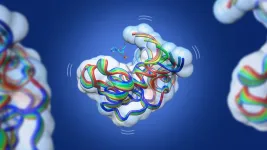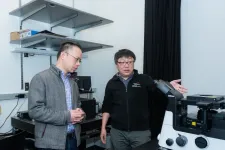(Press-News.org) Professor Nicolas Doucet and his team at Institut national de la recherche scientifique (INRS) made a major breakthrough earlier this year in the field of evolutionary conservation of molecular dynamics in enzymes. Their work, published in the journal Structure, points to potential applications in health, including the development of new drugs to treat serious diseases such as cancer or to counter antibiotic resistance.
As a researcher specializing in protein dynamics, Professor Doucet is captivated by things that are invisible to the naked eye, yet full of mysteries and essential to all forms of life. He studies proteins and enzymes, and the poorly understood links between their structure, function, and motion at the atomic scale.
To better envision unexplored avenues of enquiry, the enzyme engineering specialist starts by examining problems from a conceptual standpoint.
“A bit of imagination may be all it takes to envision multiple paths of enquiry in this tiny world we still know relatively little about, but the scientific process is very meticulous,” said Professor Doucet, a researcher at the Armand-Frappier Santé Biotechnologie Research Centre and scientific co-head of the Nuclear Magnetic Resonance Spectroscopy Lab at INRS.
Towards a better understanding of macromolecular function
As part of this study, Professor Doucet’s team investigated an issue considered fundamental by experts in the field: if a particular protein or enzyme relies on the conformational change of its three-dimensional structure to perform its biological function in humans, do homologous enzymes in other vertebrates or other living organisms also depend on these same conformational changes? In other words, if certain motions are essential to the biological function of proteins and enzymes, are these conformation changes selected and conserved as a molecular evolutionary mechanism in all forms of life?
Despite our very limited understanding of how these macromolecules essential to life on Earth actually work, the team attempted to answer this question.
Developments in biochemical and biophysical technology in recent decades have made it easier to observe the molecular structures of proteins and enzymes.
“We studied different enzymes of the same family to analyze several proteins exhibiting the same biological function. We compared their atomic-scale motions to uncover whether they are preserved throughout evolution. Despite overall similarities between species, we were surprised to find that, on the contrary, movements are divergent,” explained the lead author of the study, David Bernard, an INRS graduate who was a PhD student in Professor Doucet’s lab at the time. He now works as a researcher at NMX.
Molecular motions of great importance
The molecular function of a protein or enzyme depends on its amino acid sequence, but also on its three-dimensional (3D) structure. In recent years, scientists have discovered that protein dynamics are closely linked to the biological activity of certain enzymes and proteins.
If this is the case for a given enzyme, what about the conservation of these motions from an evolutionary standpoint? In other words, are specific atomic motions in an enzyme family always present and similarly conserved to preserve biological function?
This would imply that the atomic-scale motions within proteins are an important determinant of the selective pressure experienced to preserve biological function, similar to the preservation of an amino acid sequence or a protein structure.
In the article, Professor Doucet’s team and their U.S. collaborators present a molecular and dynamic analysis of several ribonucleases, enzymes known as RNases that catalyze the degradation of RNA into smaller elements. RNases from a handful of vertebrate species, including primates and humans, were selected based on their structural and functional homology.
This study, which builds on *previously published research by the team, convincingly demonstrates that RNases that retain specific biological functions in various species also maintain a very similar dynamic profile among themselves. In contrast, structurally similar RNases with distinct biological function demonstrate a unique dynamic profile, strongly suggesting that the preservation of dynamics is related to biological function in these biocatalysts.
Elucidating the motions essential to the function of a protein or enzyme therefore holds promise for exploiting its therapeutic potential. This could provide a potential target for controlling protein and enzyme functions in the cell, a field known as allosteric modulation or inhibition.
For example, successfully inhibiting an enzyme by binding a drug to its active (or orthosteric) site while also targeting an allosteric site on the surface of a protein could kill two birds with one stone. The idea here is to inhibit the active site of the enzyme while at the same time disrupting its molecular dynamics by targeting an allosteric site. This inhibitory action would also significantly reduce the development of antibiotic resistance.
Drug resistance is a global health issue. In recent years, one of the most compelling and widely publicized examples of this has been antibiotic resistance in the fight against bacteria that infect humans and farm animals.
In conclusion, since specific molecular motions are uniquely observable in some enzyme families, this would allow researchers to achieve a remarkable degree of selectivity in developing unique allosteric inhibitors—all without affecting structurally or functionally homologous enzymes.
*Article published in Structure (2018)
Editorial
About the publication
The article “Conformational exchange divergence along the evolutionary pathway of eosinophil-associated ribonucleases” was published on March 2, 2023, in the Cell Press journal Structure, by David N. Bernard, Chitra Narayanan, Tim Hempel, Khushboo Bafna, Purva Prashant Bhojane, Myriam Létourneau, Elizabeth E. Howell, Pratul K. Agarwal, and Nicolas Doucet.
This research was primarily funded by the Natural Sciences and Engineering Research Council of Canada (NSERC), Fonds de Recherche Québec - Santé (FRQS), the National Institutes of Health (NIH) in the United States, and the Armand-Frappier Foundation.
END
Because we don’t have crystal balls to show us how the world used to look, scientists must rely on preserved artifacts and specimens to provide the details. Below are some recent papers published in ACS journals that have unearthed insights from historic items and provided suggestions for protecting relics. Reporters can request free access to these papers by emailing newsroom@acs.org.
“Two Pathways for the Degradation of Orpiment Pigment (As2S3) Found in Paintings”
Journal of the American Chemical Society
April 14, 2023
Oil paintings created before the 19th century often ...
Globally, air pollution is a major public health hazard. A key air pollutant linked to health risks is ambient fine particulate matter (PM2.5), which consists of minute particles, sized less than or equal to 2.5 μm, suspended in the air. According to the WHO, annual PM2.5 levels should not exceed 5 μg/m3. However, the current PM2.5 levels in China far exceed this standard and are responsible for approximately 1.4 million PM2.5-related excess deaths annually. Even as the country steadily works towards reducing ...
(Boston)—The quality of surgery can drastically influence both short- and long-term postoperative outcomes and is a crucial consideration in studies that assess surgical outcomes. One approach for developing accurate quality measures is benchmarking, a quality-improvement process in which the best possible outcomes are identified to serve as a point of reference against which performance can be compared.
Surgery for gallbladder cancer (GBC) is a technically challenging surgical procedure and requires considerable expertise ...
It’s often risky to introduce new products to the market. In fact, statistics show that between 40 to 90 percent of new products fail. A key component of product adoption is consumer psychology. While there are a few theories that attempt to explain why certain people are not likely to accept novelties, a new study takes a slightly different approach.
Florida Atlantic University and collaborators developed and introduced a new mathematical innovation model, grounded in psychology, to provide both qualitative and quantitative predictions of adoption trends for new products.
The objective of the study ...
The experience of the jihadist terrorist attacks that plagued Western Europe between 2015 and 2017 shows that perceived threats from ethnic and religious minorities affect the tone of public discourse about immigration and the support for radical right parties, according to a new study which uses German data, including more than 10mln tweets.
In that period, terrorist attacks and instances of crime involving minorities made immigration a more salient issue for voters, explain Bocconi scholars Francesco Giavazzi (Bocconi University, Milan) and Gaia Rubera (Bocconi ...
CLEVELAND, Ohio (May 8, 2023)—As the population continues to age, there is greater focus on bone health and minimizing fractures to maintain mobility. A new study suggests that various types of hormone therapies not only increase lumbar spine bone mineral density (BMD) in postmenopausal women but also protect against bone loss, even after hormones have been discontinued. Study results are published online in Menopause, the journal of The North American Menopause Society (NAMS).
Osteoporosis is a common debilitating condition, ...
Pacemakers and other implantable devices that restore normal heart rhythms have saved millions of lives.
In some patients, a pacemaker or implantable cardioverter defibrillator modified for “cardiac resynchronization therapy,” or CRT, can dramatically improve heart failure by synchronizing the heart’s pumping function. Unfortunately, many people don’t respond to CRT and of those who do, some don’t realize its full potential — including increased exercise capacity and staying out of the hospital.
CRT can save or change many more lives, says Miaomiao Zhang, an assistant professor at the University of Virginia School ...
Collaborative research at the University of Cincinnati has developed a new probe to better study cells that has already led to new knowledge about certain cellular processes.
UC’s Jiajie Diao, PhD, and Yujie Sun, PhD, are lead authors on new research published May 4 in ACS Sensors.
Focus on endolysosomes
The team’s research focused on organelles, or specialized structures that perform various jobs inside cells, called endolysosomes. Lysosomes are organelles that act as the “recycling center” of the cell, reusing ...
Researchers at North Carolina State University have developed a complex model to improve how quickly first responders – such as police and EMTs – reach the scene of vehicle accidents. In computational testing, the model outperformed the existing techniques for getting first responders to accident sites quickly.
“The goal was to figure out the most efficient way to get first responders to an accident,” says Leila Hajibabai, corresponding author of a paper on the work and an assistant professor in NC State’s Edward P. Fitts Department of Industrial and Systems Engineering. “Where should first responders be based ...
Thalassemia (thal-uh-SEE-me-uh) is an inherited blood disorder that affects about 300 million people worldwide. Treatments for moderate to severe thalassemia include frequent blood transfusions, chelation therapy to remove excess iron from the blood, and hematopoietic stem cell transplantation (HSCT).
In line with the theme of this year's International Thalassemia Day – "Be Aware. Share. Care: Strengthening Education to Bridge the Thalassemia Care Gap", BGI Genomics will co-host an event with the Shenzhen Municipal Health Commission for thalassemia patients and their family members on May 6, 2023, in Shenzhen, China, providing tips on ...






